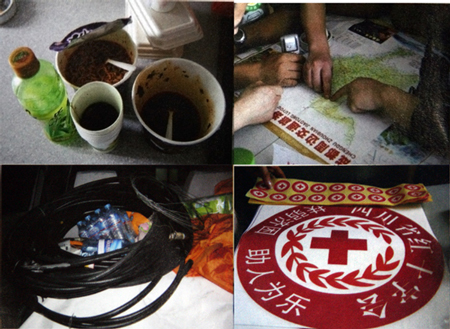
Top left: Instant noodles, an on-duty Ham's food for the day.
Top right: Command Group checks positions on the map;
Bottom left: Spare cables and water in Liu Xu's Jeep;
Bottom right: Vehicle permits issued by the Red Cross.
An invaluable amateur radio rescue force
According to Liu Hu, thousands of Ham volunteers took part in the rescue effort. Approximately 300 pages of duty records, 30 hours audio, 2 hours video and 2GB of photos were taken in the six days following the earthquake. Meanwhile, under SARES control more than 3,000 vehicles helped with relief work and thousands of injured were evacuated. SARES also provided radio relay communication for Hanwang, Shifang, Xindu and Dujiangyan.
As Amateur Radio can respond and transmit very quickly, it becomes very important when official communication channels are down. The SARES center set up three groups for the rescue: Command group, Information group, and Logistics group. Information group was in charge of organizing information from the disaster areas and reporting urgent needs, so that Command Group could arrange Ham volunteers to send the supplies. Logistics group was responsible for providing logistics to the working radio stations in disaster areas. Logistic supply work was much tougher after the disaster than it normally would be.
SARES' significant achievements stemmed from the Chinese Radio Relay League's May 14th announcement appealing to all Hams to participate in the rescue communication effort. The announcement asked all Hams to "keep listening to common shortwave radio frequencies, pass on any information or news picked up from radio stations in the disaster area to Local Government, and try to provide as much assistance as possible, in particular helping people around the disaster area to contact their families". In addition, the Ham should maintain a careful watch for channel or frequency conflicts between amateur radio stations and Government Emergency Communications, and immediately give way to the emergency communication.
A Ham from Tianjin with radio call sign BD1QMP suggested that Chinese Hams could found an Amateur Radio Emergency Service Group in China, and benefit from the experience of the International ARES organizations. The group should establish tactics, rules and procedures, contact local emergency service institutions, and coordinate training.
"We should train members very well – in the case of any future disaster we need to be able to get involved in the rescue immediately." One Ham has already started to translate the American ARES handbook.
Notes:
The radio station's call signs: BA6AA, BG8AAS, BGBCVE...... each radio call sign is the legal code that represents one radio station or one radio operator during the radio communication. Chinese amateur radio call signs start with the letter "B", and the second letter represents the station's type. "Y" refers to collective radio stations; "A" refers to level 1 personal radio stations; "D" represents level 2 personal radio stations; and, "G" represents level 3 to 5 personal radio stations. The first number in the sign indicates each station's area, and the next two or three letters are the personal code for each inpidual operator. This means that, every radio call sign in the world is unique.
(Source: New Weekly, translated by Yang Xi, Wu Huanshu & Yan Xiaoqing for China.org.cn, June 24, 2008)